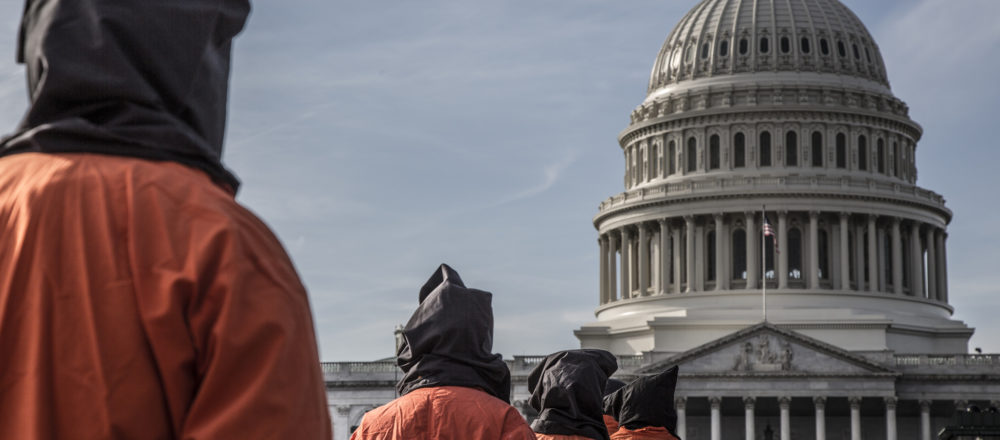Aliya Hussain is the advocacy program manager for the Guantanamo Global Justice Initiative at the Center for Constitutional Rights (CCR) based in New York. The center is a strategic litigation and advocacy organisation with a long history of providing legal support to progressive movements.
Back in early 2002, CCR was one of the first organisations to take on the Guantanamo cases, representing Australian man David Hicks. Since then, it has played a pivotal role in advocating for the prison’s closure, including representing numerous detainees and coordinating a pro bono “Gitmo Bar” of hundreds of lawyers across the country.
Aliya’s role is focused on advocating for CCR’s clients and coordinating public education campaigns. In this capacity, Aliya often acts as a liaison between grassroots activists and lawyers and develops creative partnerships to bring the stories of CCR’s clients to new audiences.
Aliya and I sat down to talk about her work and how to engage people with human rights issues and carve out change against a political backdrop of fear and secrecy.
Katharine Brown: CCR’s approach to litigation and public advocacy is described as “movement lawyering”. Could you expand a bit on what this means and the rationale behind it?
Aliya Hussain: I see a movement lawyering approach as one of taking leadership from the movements that we’re representing and the individuals most directly impacted. I think it’s really about understanding what our role is as lawyers and advocates and how we can best help, but also recognising that law has its limits. It can be used as a form of oppression, but also as a tool to build power. Building power is one of the primary goals of our legal work.
A unique thing about the work CCR does is that advocacy campaigns are run in tandem with litigation. Can you tell me a bit more about the rationale for this approach and how effective it is in practice? Is it connected to what you were saying about the limits of the law?
I think it’s about recognising that there are limits to legal intervention, and as we sometimes say, a multi-pronged approach can lead to a sort of “success without victory”. So, for example, we might not win a case – it might be dismissed in Federal Court, yet we might still be successful in getting our clients off a no-fly list or bringing attention to an issue that was otherwise completely secret.
I think that litigation can often be the entry point of our involvement in a case and it can give us a platform. We then have to utilise other forms of communications or advocacy in tandem.
Take freedom-of-information litigation as an example: it’s a legal tool that you can use to access a lot of information when the Government is not turning it over. But then what do you do with that information? The point is to get it out to as many people as possible, to pitch it to the media and to show what might be happening around a specific issue.
And how has this approach played out in your work with Guantanamo? Is it accurate to say that the early years were really focused on litigation, but more recently it’s been about political advocacy?
Well, when Guantanamo first opened it was this rule-of-law question; it was a legal problem – how can you have a place that exists outside of the law? And so much of that early work was about bringing the law to Guantanamo. Once the court ruled that the men had the right to habeas corpus then you had CCR playing this role coordinating pro bono lawyers all over the country to take on these cases.
In the early years, the US Federal Court was granting something like 75 per cent of all habeas cases. But then in 2009-10 the Court of Appeal became much more hostile to these cases and started to reverse lower court decisions. It became clear the courts were abandoning Guantanamo and litigation was just not going to get people out. At that time it also became clear that Guantanamo was a political problem just as much as a legal problem.
And that’s where the advocacy side of CCR’s role really came to the fore, focusing on the public advocacy component. One great example of the kind of broader, awareness-raising work done by CCR was the release of the short film Waiting for Fahd. Can you tell us about that project?
Sure. We had two goals with the film. The first was to get Fahd released, to show that he had a community and a family that was ready to receive him, take care of him and help him re-build his life. The second was to use it as a tool more generally in our Guantanamo work to show that the impact of indefinite detention extends beyond the people detained to their families and communities.
We thought using the medium of a film would make it easier to share the message.. It was a new tool that allowed us to reach new audiences.
And so thinking about the film and some of your other projects, what advice would you give to activists and lawyers working in this space about how to get your message across to the public, and particularly how to reach new audiences?
In terms of engaging new audiences, I would say three things. The first is partnering with some unlikely folks and for us that has long been artists, cultural actors and using their spaces as a way to further our message.
I think a second thing is when we do our storytelling we really try to pull out aspects of our clients’ stories that are universal and that resonate with people. For example, in Waiting for Fahd, so much of that story was about a family missing their son and wanting him back so they could live together peacefully. That’s the main story, and it just happens that their son lives in Guantanamo. You try to get people to see the humanity, and when that happens, the barriers fall.
The last thing that we’re trying to do is to make connections between this issue and other issues. One of our Guantanamo clients said it best. He was watching so much of the uproar around police killings of unarmed black men in the US and making connections between that and what was going on with him in Guantanamo. He recognised that they are both part of a larger system of oppression where the State can act with impunity. So Guantanamo is not just a legal problem, and an extreme example of human rights abuse, but also part of a broader continuum. And that can trigger people who might think “well Guantanamo has nothing to do with me” to rethink that attitude and recognise that it’s actually part of a larger system.
What would your advice be for lawyers wanting to get involved with movement lawyering work? Are there any pitfalls to be aware of?
I think that lawyers are trained in a very particular way and that training can prepare them for many situations that the rest of us are not equipped to handle, but at the same time I think the law has lots of rules and that can be confining sometimes. It can prevent people from taking risks, being a bit creative or seeing solutions outside of the law.
I also think that being a lawyer comes with privilege in terms of the spaces that you’re able to access and the ears that will listen to things you say. I think that if that privilege is not checked before working with other groups, it can be problematic. The lawyer is not always right on what the issues are or what the client’s needs are.
Some of the most effective movement lawyers I’ve seen know what their role is but also recognise that if you’re helping a person, sometimes that person knows what’s best for them and the change that they want to see.



